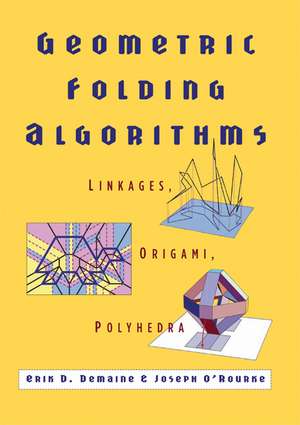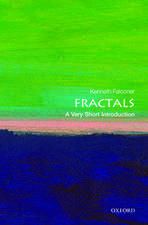Geometric Folding Algorithms: Linkages, Origami, Polyhedra
Autor Erik D. Demaine, Joseph O'Rourkeen Limba Engleză Paperback – 20 aug 2008
| Toate formatele și edițiile | Preț | Express |
|---|---|---|
| Paperback (1) | 432.63 lei 6-8 săpt. | |
| Cambridge University Press – 20 aug 2008 | 432.63 lei 6-8 săpt. | |
| Hardback (1) | 1094.79 lei 6-8 săpt. | |
| Cambridge University Press – 15 iul 2007 | 1094.79 lei 6-8 săpt. |
Preț: 432.63 lei
Preț vechi: 486.10 lei
-11% Nou
Puncte Express: 649
Preț estimativ în valută:
82.79€ • 88.52$ • 69.02£
82.79€ • 88.52$ • 69.02£
Carte tipărită la comandă
Livrare economică 18 aprilie-02 mai
Preluare comenzi: 021 569.72.76
Specificații
ISBN-13: 9780521715225
ISBN-10: 0521715229
Pagini: 496
Ilustrații: 82 b/w illus. 330 colour illus. 16 tables
Dimensiuni: 175 x 251 x 25 mm
Greutate: 0.84 kg
Ediția:1
Editura: Cambridge University Press
Colecția Cambridge University Press
Locul publicării:New York, United States
ISBN-10: 0521715229
Pagini: 496
Ilustrații: 82 b/w illus. 330 colour illus. 16 tables
Dimensiuni: 175 x 251 x 25 mm
Greutate: 0.84 kg
Ediția:1
Editura: Cambridge University Press
Colecția Cambridge University Press
Locul publicării:New York, United States
Cuprins
Introduction; Part I. Linkages: 1. Problem classification and examples; 2. Upper and lower bounds; 3. Planar linkage mechanisms; 4. Rigid frameworks; 5. Reconfiguration of chains; 6. Locked chains; 7. Interlocked chains; 8. Joint-constrained motion; 9. Protein folding; Part II. Paper: 10. Introduction; 11. Foundations; 12. Simple crease patterns; 13. General crease patterns; 14. Map folding; 15. Silhouettes and gift wrapping; 16. The tree method; 17. One complete straight cut; 18. Flattening polyhedra; 19. Geometric constructibility; 20. Rigid origami and curved creases; Part III. Polyhedra: 21. Introduction and overview; 22. Edge unfolding of polyhedra; 23. Reconstruction of polyhedra; 24. Shortest paths and geodesics; 25. Folding polygons to polyhedra; 26. Higher dimensions.
Recenzii
'Demaine and O'Rourke are among the best-qualified authors for a book on this subject; and the book that they have written is a delight … it is exceptionally clear and readable. It could be read for pleasure by any mathematics undergraduate, and much of it (though not all) by amateurs with a high school mathematics background … although there are sections that some amateurs will skip, the level is always kept as elementary as locally possible. This book should be in all university libraries, and many professional and amateur mathematicians will want to add it to their personal collections.' Robert Dawson (Halifax), Zentralblatt Math
'This book is one of those rare mathematics books that I had a hard time putting down. I wanted to keep reading to find the next insight. … This is a serious mathematics book whose explorations have significant applications and real mathematical profundity, wonderfully mixed with some fun recreational mathematics. … The book has a useful index and an extensive bibliography, so when you finish reading, it will remain a valuable resource far into the future. There is a lot of material in this book and it is really a lot of fun. I highly, highly recommend this book to anyone with even a passing interest in folding mathematics.' MAA Reviews
'The authors explain step-by-step interesting solutions of some folding problems. This splendidly illustrated book can be interesting for advanced undergraduate students in mathematics and computer science as well as for geometers and computer specialists who can find many new ideas and impulses …' EMS Newsletter
'This book is one of those rare mathematics books that I had a hard time putting down. I wanted to keep reading to find the next insight. … This is a serious mathematics book whose explorations have significant applications and real mathematical profundity, wonderfully mixed with some fun recreational mathematics. … The book has a useful index and an extensive bibliography, so when you finish reading, it will remain a valuable resource far into the future. There is a lot of material in this book and it is really a lot of fun. I highly, highly recommend this book to anyone with even a passing interest in folding mathematics.' MAA Reviews
'The authors explain step-by-step interesting solutions of some folding problems. This splendidly illustrated book can be interesting for advanced undergraduate students in mathematics and computer science as well as for geometers and computer specialists who can find many new ideas and impulses …' EMS Newsletter
Notă biografică
Descriere
Lavishly illustrated and entertaining account of the surprising and useful results of the maths of folding and unfolding.















